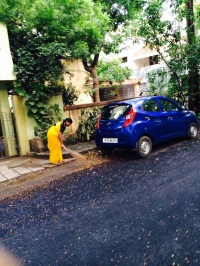Chennai morning walks, design Kolams and crispy Dosais!
I am currently on a home visit to Chennai( Madras), South India where my parents have lived for the past 32 years. My father begins his day with a ritual morning walk and yoga asanas. I love to join him for these walks as they offer me some time and space for my own thoughts & reflections. During these walks one gets a glimpse of local culture, ancient customs and a modern India all at the same time.
The neighbourhood is lush from the recent showers and quiet( almost as quiet as my neighbourhood in Stockholm) at this time of the day, before the hustle and bustle starts. As we make our ususal rounds my father always stops by at a statue of the elephant God Ganesha. Ganesha the harbinger of Good Luck is always evoked for new starts + fresh beginnings and has a universal appeal in a secular India and beyond. Sometimes the local priest is there giving the Ganesha a ritual bath and dressed in new garments with fresh flowers and incense.

As we continue walking past the beautiful homes in the neighbourhood we hear the sound of jharus( brooms) sweeping clean yesterdays dry leaves, twigs and fallen flowers, going back and forth, the front of the houses are meticulously cleaned. One then sees the lady of the house or their housekeeper casting water to help settle any dust in the area. She then goes in and brings out a small bowl filled with a white chalk like powder, its rice powder with which she then draws beautiful geometrical designs called Kolam. the same scene is repeated all over Chennai and Tamil Nadu where millions of women draw kolams on the ground with white rice powder. Through the day, the drawings get walked on, rained out, or blown around in the wind; new ones are made the next day.
Kolams are a symbol of auspiciousness. It is Hindu belief that that the geometrical patterns & designs applied with rice flour at the entrance to a home, invites Goddess Lakshmi( Goddess of Wealth) into the household, and drives away the evil spirits. I love the humanistic and universal design thinking here as the rice flour provides food for the ants, birds & other small insects.
Intrestingly the sanskrit word for rice is varisi; from varisi came the tamil word arisi which was exported with rice itself from South India to Europe and gave rise to the english word Rice or Ris in Swedish. No breakfast in South India can be served without something with rice. One of the most popular breakfast dishes in Chennai (Madras) is the Dosai. Dosai is a south indian savoury pancake , naturally vegan and made by grinding rice grits with urad dhal( lentils) and left to ferment overnight. The dosais of tamil nadu(Chennai) are thick and small while those of Karnataka (Bangalore) are thin large and crisp. The thicker version of the same batter is also used to make idlis which are delicious fluffy steamed patties. Accompanying a dosai or an idli will be sambhar (a yummy spicy tangy lentil sauce) along with freshly ground cocnout chutney of various sorts like tomato, mint etc. If you order a masala dosa you will find the pancake will have enclosed a masala of mashed potatoes, onions and green chilies.
We know from reading old Tamil literature or Sangam literature that dosais were first noted around 6th century AD and could possibly be older. So one can still experience history, taste fantastic heritage and relive traditions and customs in a modern India.
Sanjoo arranges South Indian Cooking classes in Stockholm :http://ootbtravel.com/indisk-matlagningskurs-temasydindien/
and leads a fascinating Culinary Tour through South India with the Swedish travel company Läs och Res: http://lasochres.se/Resor/Asien/Indien/Sydindiens_smaker



